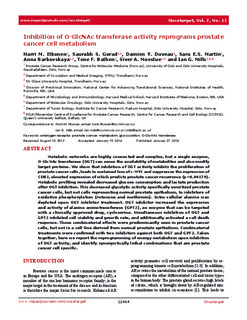| dc.contributor.author | Itkonen, Harri | |
| dc.contributor.author | Gorad, Saurabh Sayajirao | |
| dc.contributor.author | Duveau, Damien Y. | |
| dc.contributor.author | Martin, Sara E.S. | |
| dc.contributor.author | Barkovskaya, Anna | |
| dc.contributor.author | Bathen, Tone Frost | |
| dc.contributor.author | Moestue, Siver Andreas | |
| dc.contributor.author | Mills, Ian Geoffrey | |
| dc.date.accessioned | 2016-09-09T07:15:33Z | |
| dc.date.accessioned | 2016-09-12T13:57:59Z | |
| dc.date.available | 2016-09-09T07:15:33Z | |
| dc.date.available | 2016-09-12T13:57:59Z | |
| dc.date.issued | 2016 | |
| dc.identifier.citation | OncoTarget 2016, 7(11):12464-12476 | nb_NO |
| dc.identifier.issn | 1949-2553 | |
| dc.identifier.uri | http://hdl.handle.net/11250/2406280 | |
| dc.description.abstract | Metabolic networks are highly connected and complex, but a single enzyme, O-GlcNAc transferase (OGT) can sense the availability of metabolites and also modify target proteins. We show that inhibition of OGT activity inhibits the proliferation of prostate cancer cells, leads to sustained loss of c-MYC and suppresses the expression of CDK1, elevated expression of which predicts prostate cancer recurrence (p=0.00179). Metabolic profiling revealed decreased glucose consumption and lactate production after OGT inhibition. This decreased glycolytic activity specifically sensitized prostate cancer cells, but not cells representing normal prostate epithelium, to inhibitors of oxidative phosphorylation (rotenone and metformin). Intra-cellular alanine was depleted upon OGT inhibitor treatment. OGT inhibitor increased the expression and activity of alanine aminotransferase (GPT2), an enzyme that can be targeted with a clinically approved drug, cycloserine. Simultaneous inhibition of OGT and GPT2 inhibited cell viability and growth rate, and additionally activated a cell death response. These combinatorial effects were predominantly seen in prostate cancer cells, but not in a cell-line derived from normal prostate epithelium. Combinatorial treatments were confirmed with two inhibitors against both OGT and GPT2. Taken together, here we report the reprogramming of energy metabolism upon inhibition of OGT activity, and identify synergistically lethal combinations that are prostate cancer cell specific. | nb_NO |
| dc.language.iso | eng | nb_NO |
| dc.publisher | Impact Journals | nb_NO |
| dc.rights.uri | https://creativecommons.org/licenses/by/3.0/ | |
| dc.title | Inhibition of O-GlcNAc transferase activity reprograms prostate cancer cell metabolism | nb_NO |
| dc.type | Journal article | nb_NO |
| dc.type | Peer reviewed | nb_NO |
| dc.date.updated | 2016-09-09T07:15:33Z | |
| dc.source.pagenumber | 12464-12476 | nb_NO |
| dc.source.volume | 7 | nb_NO |
| dc.source.journal | OncoTarget | nb_NO |
| dc.source.issue | 11 | nb_NO |
| dc.identifier.doi | 10.18632/oncotarget.7039 | |
| dc.identifier.cristin | 1320026 | |
| dc.relation.project | Norges forskningsråd: 239940 | nb_NO |
| dc.description.localcode | All site content, except where otherwise noted, is licensed under a Creative Commons Attribution 3.0 License. PII: 7039 | nb_NO |

